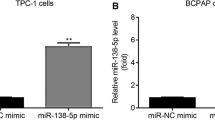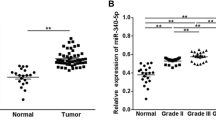Abstract
To explore the potential mechanism of microRNA (miR)-181b-5p promoting the progression of thyroid cancer (TC) by targeting programmed cell death 4 (PDCD4). Analysis of miR-181b-5p and PDCD4 expression in TC was performed. The impact of miR-181b-5p and PDCD4 on proliferation, migration, invasion, and apoptosis of TC cells was examined. The binding relationship between miR-181b-5p and PDCD4 was predicted and verified. miR-181b-5p was up-regulated in TC, while PDCD4 was down-regulated. Down-regulating miR-181b-5p or up-regulating PDCD4 inhibited the proliferation, migration, and invasion of TC cells, and promoted cell apoptosis. PDCD4 was the downstream target of miR-181b-5p, and down-regulation of PDCD4 counteracted the inhibitory effect of down-regulation of miR-181b-5p on the proliferation, migration, and invasion of TC cells and the promoting effect on apoptosis. miR-181b-5p inhibits the proliferation, migration, and invasion of TC cells and promotes cell apoptosis by targeting PDCD4.





Similar content being viewed by others
Data availability
Not applicable.
References
García-Gómez, F. J., la Riva-Pérez, P. A., Calvo-Morón, C., Buján-Lloret, C., Cambil-Molina, T., & Castro-Montaño, J. (2017). Intrathoracic stomach mimicking bone metastasis from thyroid cancer in whole-body iodine-131 scan diagnosed by SPECT/CT. Archives of Endocrinology and Metabolism, 61(3), 288–290. https://doi.org/10.1590/2359-3997000000243
Korkmaz, M. H., Öcal, B., Saylam, G., Çakal, E., Bayır, Ö., Tutal, E., & Tatar, E. (2017). The need of prophylactic central lymph node dissection is controversial in terms of postoperative thyroglobulin follow-up of patients with cN0 papillary thyroid cancer. Langenbeck’s Archives of Surgery, 402(2), 235–242. https://doi.org/10.1007/s00423-017-1556-y
Zaballos, M. A., & Santisteban, P. (2017). Key signaling pathways in thyroid cancer. Journal of Endocrinology, 235(2), R43-r61. https://doi.org/10.1530/joe-17-0266
Byeon, H. K., Na, H. J., Yang, Y. J., Ko, S., Yoon, S. O., Ku, M., Yang, J., Kim, J. W., Ban, M. J., Kim, J. H., Kim, D. H., Kim, J. M., Choi, E. C., Kim, C. H., Yoon, J. H., & Koh, Y. W. (2017). Acquired resistance to BRAF inhibition induces epithelial-to-mesenchymal transition in BRAF (V600E) mutant thyroid cancer by c-Met-mediated AKT activation. Oncotarget, 8(1), 596–609. https://doi.org/10.18632/oncotarget.13480
Kunawudhi, A., Promteangtrong, C., & Chotipanich, C. (2016). A case report of hyperfunctioning metastatic thyroid cancer and rare I-131 avid liver metastasis. Indian Journal of Nuclear Medicine, 31(3), 210–214. https://doi.org/10.4103/0972-3919.183616
Park, S. H., Seo, M., Park, T. Y., & Nam-Goong, S. (2016). An intrapericardial ectopic thyroid mimicking metastasis in a patient with papillary thyroid cancer: Localization, differential diagnosis by (18)F-FDG PET/CT and ablation by (131)I. Hellenic Journal of Nuclear Medicine, 19(3), 272–274. https://doi.org/10.1967/s002449910411
Trzybulska, D., Bobjer, J., Giwercman, A., & Tsatsanis, C. (2017). Serum microRNAs in male subfertility-biomarkers and a potential pathogenetic link to metabolic syndrome. Journal of Assisted Reproduction and Genetics, 34(10), 1277–1282. https://doi.org/10.1007/s10815-017-0989-0
Feliciano, A., Garcia-Mayea, Y., Jubierre, L., Mir, C., Hummel, M., Castellvi, J., Hernández-Losa, J., Paciucci, R., Sansano, I., Sun, Y., Ramón, Y. C. S., Kondon, H., Soriano, A., Segura, M., Lyakhovich, A., & LLeonart, M. E. (2017). miR-99a reveals two novel oncogenic proteins E2F2 and EMR2 and represses stemness in lung cancer. Cell Death & Disease, 8(10), e3141. https://doi.org/10.1038/cddis.2017.544
Mansoori, B., Duijf, P. H. G., Mohammadi, A., Safarzadeh, E., Ditzel, H. J., Gjerstorff, M. F., Cho, W. C., & Baradaran, B. (2021). MiR-142-3p targets HMGA2 and suppresses breast cancer malignancy. Life Sciences, 276, 119431. https://doi.org/10.1016/j.lfs.2021.119431
Zuberi, M., Khan, I., Mir, R., Gandhi, G., Ray, P. C., & Saxena, A. (2016). Utility of serum miR-125b as a diagnostic and prognostic indicator and its alliance with a panel of tumor suppressor genes in epithelial ovarian cancer. PLoS ONE, 11(4), e0153902. https://doi.org/10.1371/journal.pone.0153902
Hill, M., & Tran, N. (2018). MicroRNAs regulating microRNAs in cancer. Trends Cancer, 4(7), 465–468. https://doi.org/10.1016/j.trecan.2018.05.002
Chen, S., Liu, Y., Wang, Y., & Xue, Z. (2019). LncRNA CCAT1 promotes colorectal cancer tumorigenesis via a miR-181b-5p/TUSC3 axis. Oncotargets and Therapy, 12, 9215–9225. https://doi.org/10.2147/ott.S216718
Chen, X., Li, M., Zhou, H., & Zhang, L. (2019). miR-132 targets FOXA1 and exerts tumor-suppressing functions in thyroid cancer. Oncology Research, 27(4), 431–437. https://doi.org/10.3727/096504018x15201058168730
Pełka, K., Klicka, K., Grzywa, T. M., Gondek, A., Marczewska, J. M., Garbicz, F., Szczepaniak, K., Paskal, W., & Włodarski, P. K. (2021). miR-96-5p, miR-134-5p, miR-181b-5p and miR-200b-3p heterogenous expression in sites of prostate cancer versus benign prostate hyperplasia-archival samples study. Histochemistry and Cell Biology, 155(3), 423–433. https://doi.org/10.1007/s00418-020-01941-2
Xie, X., Sun, F. K., Huang, X., Wang, C. H., Dai, J., Zhao, J. P., Fang, C., & He, W. (2021). A circular RNA, circSMARCA5, inhibits prostate cancer proliferative, migrative, and invasive capabilities via the miR-181b-5p/miR-17-3p-TIMP3 axis. Aging (Albany NY), 13(15), 19908–19919. https://doi.org/10.18632/aging.203408
Yeon, M., Kim, Y., Pathak, D., Kwon, E., Kim, D. Y., Jeong, M. S., Jung, H. S., & Jeoung, D. (2021). The CAGE-MiR-181b-5p-S1PR1 axis regulates anticancer drug resistance and autophagy in gastric cancer cells. Frontiers in Cell and Developmental Biology, 9, 666387. https://doi.org/10.3389/fcell.2021.666387
Ahmed, S. H., Espinoza-Sánchez, N. A., El-Damen, A., Fahim, S. A., Badawy, M. A., Greve, B., El-Shinawi, M., Götte, M., & Ibrahim, S. A. (2021). Small extracellular vesicle-encapsulated miR-181b-5p, miR-222-3p and let-7a-5p: Next generation plasma biopsy-based diagnostic biomarkers for inflammatory breast cancer. PLoS ONE, 16(4), e0250642. https://doi.org/10.1371/journal.pone.0250642
Cinegaglia, N. C., Andrade, S. C., Tokar, T., Pinheiro, M., Severino, F. E., Oliveira, R. A., Hasimoto, E. N., Cataneo, D. C., Cataneo, A. J., Defaveri, J., Souza, C. P., Marques, M. M., Carvalho, R. F., Coutinho, L. L., Gross, J. L., Rogatto, S. R., Lam, W. L., Jurisica, I., & Reis, P. P. (2016). Integrative transcriptome analysis identifies deregulated microRNA-transcription factor networks in lung adenocarcinoma. Oncotarget, 7(20), 28920–28934. https://doi.org/10.18632/oncotarget.8713
Fahim, S. A., Abdullah, M. S., Espinoza-Sánchez, N. A., Hassan, H., Ibrahim, A. M., Ahmed, S. H., Shakir, G., Badawy, M. A., Zakhary, N. I., Greve, B., El-Shinawi, M., Götte, M., & Ibrahim, S. A. (2020). Inflammatory breast carcinoma: Elevated microRNA miR-181b-5p and reduced miR-200b-3p, miR-200c-3p, and miR-203a-3p expression as potential biomarkers with diagnostic value. Biomolecules. https://doi.org/10.3390/biom10071059
Wang, Q., & Yang, H. S. (2018). The role of Pdcd4 in tumour suppression and protein translation. Biology of the Cell. https://doi.org/10.1111/boc.201800014
Zhen, Y., Fang, W., Zhao, M., Luo, R., Liu, Y., Fu, Q., Chen, Y., Cheng, C., Zhang, Y., & Liu, Z. (2017). miR-374a-CCND1-pPI3K/AKT-c-JUN feedback loop modulated by PDCD4 suppresses cell growth, metastasis, and sensitizes nasopharyngeal carcinoma to cisplatin. Oncogene, 36(2), 275–285. https://doi.org/10.1038/onc.2016.201
Pennelli, G., Fassan, M., Mian, C., Pizzi, M., Balistreri, M., Barollo, S., Galuppini, F., Guzzardo, V., Pelizzo, M., & Rugge, M. (2013). PDCD4 expression in thyroid neoplasia. Virchows Archiv, 462(1), 95–100. https://doi.org/10.1007/s00428-012-1352-6
Galuppini, F., Fassan, M., Bertazza, L., Barollo, S., Cascione, L., Watutantrige-Fernando, S., Lazzarin, V., Simonato, P., Vianello, F., Rugge, M., Mian, C., & Pennelli, G. (2019). Programmed cell death 4 (PDCD4) as a novel prognostic marker for papillary thyroid carcinoma. Cancer Management and Research, 11, 7845–7855. https://doi.org/10.2147/cmar.S194344
Li, R., Teng, X., Zhu, H., Han, T., & Liu, Q. (2019). MiR-4500 regulates PLXNC1 and inhibits papillary thyroid cancer progression. Hormones and Cancer, 10(4–6), 150–160. https://doi.org/10.1007/s12672-019-00366-1
Huang, Y., Zhang, K., Li, Y., Dai, Y., & Zhao, H. (2020). The DLG1-AS1/miR-497/YAP1 axis regulates papillary thyroid cancer progression. Aging (Albany NY), 12(22), 23326–23336. https://doi.org/10.18632/aging.104121
Ren, Z. F., Du, M. F., Fu, H., Liu, J., Xia, F. Y., Du, H. N., & Liu, N. (2020). MiR-200c promotes proliferation of papillary thyroid cancer cells via Wnt/β-catenin signaling pathway. European Review for Medical and Pharmacological Sciences, 24(10), 5512–5518. https://doi.org/10.26355/eurrev_202005_21336
Boufraqech, M., Zhang, L., Jain, M., Patel, D., Ellis, R., Xiong, Y., He, M., Nilubol, N., Merino, M. J., & Kebebew, E. (2014). miR-145 suppresses thyroid cancer growth and metastasis and targets AKT3. Endocrine-Related Cancer, 21(4), 517–531. https://doi.org/10.1530/erc-14-0077
Xie, F., Li, L., Luo, Y., Chen, R., & Mei, J. (2021). Long non-coding RNA LINC00488 facilitates thyroid cancer cell progression through miR-376a-3p/PON2. Bioscience Reports. https://doi.org/10.1042/bsr20201603
Le, F., Luo, P., Yang, Q. O., & Zhong, X. M. (2017). MiR-181a promotes growth of thyroid cancer cells by targeting tumor suppressor RB1. European Review for Medical and Pharmacological Sciences, 21(24), 5638–5647. https://doi.org/10.26355/eurrev_201712_14007
Ding, Y., Wu, L., Zhuang, X., Cai, J., Tong, H., Si, Y., Zhang, H., Wang, X., & Shen, M. (2021). The direct miR-874-3p-target FAM84A promotes tumor development in papillary thyroid cancer. Molecular Oncology, 15(5), 1597–1614. https://doi.org/10.1002/1878-0261.12941
Pellegriti, G., Frasca, F., Regalbuto, C., Squatrito, S., & Vigneri, R. (2013). Worldwide increasing incidence of thyroid cancer: Update on epidemiology and risk factors. Journal of Cancer Epidemiology, 2013, 965212. https://doi.org/10.1155/2013/965212
Wang, T. S., & Sosa, J. A. (2018). Thyroid surgery for differentiated thyroid cancer—Recent advances and future directions. Nature Reviews. Endocrinology, 14(11), 670–683. https://doi.org/10.1038/s41574-018-0080-7
Erratum: Global cancer statistics 2018: GLOBOCAN estimates of incidence and mortality worldwide for 36 cancers in 185 countries. (2020). CA: A Cancer Journal for Clinicians, 70(4), 313. https://doi.org/10.3322/caac.21609
Guo, K., Wang, J., Shu, L., & Zhou, G. (2021). MiR-200c promotes papillary thyroid cancer cell proliferation, migration, and invasion by downregulating PTEN. Tissue and Cell, 73, 101647. https://doi.org/10.1016/j.tice.2021.101647
Bian, S. (2020). miR-4319 inhibited the development of thyroid cancer by modulating FUS-stabilized SMURF1. Journal of Cellular Biochemistry, 121(1), 174–182. https://doi.org/10.1002/jcb.29026
Chen, L., Wang, X., Ji, C., Hu, J., & Fang, L. (2020). MiR-506-3p suppresses papillary thyroid cancer cells tumorigenesis by targeting YAP1. Pathology - Research and Practice, 216(12), 153231. https://doi.org/10.1016/j.prp.2020.153231
Nikiforov, Y. E. (2017). Role of molecular markers in thyroid nodule management: Then and now. Endocrine Practice, 23(8), 979–988. https://doi.org/10.4158/ep171805.Ra
Nixon, A. M., Provatopoulou, X., Kalogera, E., Zografos, G. N., & Gounaris, A. (2017). Circulating thyroid cancer biomarkers: Current limitations and future prospects. Clinical Endocrinology - Oxford, 87(2), 117–126. https://doi.org/10.1111/cen.13369
Qiu, J., Zhang, W., Zang, C., Liu, X., Liu, F., Ge, R., Sun, Y., & Xia, Q. (2018). Identification of key genes and miRNAs markers of papillary thyroid cancer. Biological Research, 51(1), 45. https://doi.org/10.1186/s40659-018-0188-1
Zhang, Y., Pan, J., Xu, D., Yang, Z., Sun, J., Sun, L., Wu, Y., & Qiao, H. (2018). Combination of serum microRNAs and ultrasound profile as predictive biomarkers of diagnosis and prognosis for papillary thyroid microcarcinoma. Oncology Reports, 40(6), 3611–3624. https://doi.org/10.3892/or.2018.6776
Tian, F., Shen, Y., Chen, Z., Li, R., Lu, J., & Ge, Q. (2016). Aberrant miR-181b-5p and miR-486-5p expression in serum and tissue of non-small cell lung cancer. Gene, 591(2), 338–343. https://doi.org/10.1016/j.gene.2016.06.014
Jiang, Z. L., Zhang, F. X., Zhan, H. L., Yang, H. J., Zhang, S. Y., Liu, Z. H., Jiang, Y., Lv, L. Z., & Ke, R. S. (2022). miR-181b-5p promotes the progression of cholangiocarcinoma by targeting PARK2 via PTEN/PI3K/AKT signaling pathway. Biochemical Genetics, 60(1), 223–240. https://doi.org/10.1007/s10528-021-10084-5
Qin, Y., Zheng, Y., Huang, C., Li, Y., Gu, M., & Wu, Q. (2021). Downregulation of miR-181b-5p inhibits the viability, migration, and glycolysis of gallbladder cancer by upregulating PDHX under hypoxia. Frontiers in Oncology, 11, 683725. https://doi.org/10.3389/fonc.2021.683725
Cai, Q., Yang, H. S., Li, Y. C., & Zhu, J. (2022). Dissecting the roles of PDCD4 in breast cancer. Frontiers in Oncology, 12, 855807. https://doi.org/10.3389/fonc.2022.855807
Guo, T., Wang, J., Cheng, G., & Huang, H. (2020). miR-590-5p may regulate colorectal cancer cell viability and migration by targeting PDCD4. Experimental and Therapeutic Medicine, 20(5), 55. https://doi.org/10.3892/etm.2020.9183
Ji, C., Hu, J., Wang, X., Zheng, W., Deng, X., Song, H., Yu, Y., Luo, Q., Hua, K., Zhou, X., & Fang, L. (2021). Hsa_circ_0053063 inhibits breast cancer cell proliferation via hsa_circ_0053063/hsa-miR-330-3p/PDCD4 axis. Aging (Albany NY), 13(7), 9627–9645. https://doi.org/10.18632/aging.202707
Pennelli, G., Galuppini, F., Barollo, S., Cavedon, E., Bertazza, L., Fassan, M., Guzzardo, V., Pelizzo, M. R., Rugge, M., & Mian, C. (2015). The PDCD4/miR-21 pathway in medullary thyroid carcinoma. Human Pathology, 46(1), 50–57. https://doi.org/10.1016/j.humpath.2014.09.006
Acknowledgements
Not applicable.
Funding
Not applicable.
Author information
Authors and Affiliations
Corresponding author
Ethics declarations
Competing Interests
The authors declare that they have no competing interests.
Additional information
Publisher's Note
Springer Nature remains neutral with regard to jurisdictional claims in published maps and institutional affiliations.
Supplementary Information
Below is the link to the electronic supplementary material.
Rights and permissions
Springer Nature or its licensor (e.g. a society or other partner) holds exclusive rights to this article under a publishing agreement with the author(s) or other rightsholder(s); author self-archiving of the accepted manuscript version of this article is solely governed by the terms of such publishing agreement and applicable law.
About this article
Cite this article
Geng, X., Li, Y., Sun, Y. et al. MicroRNA-181b-5p Facilitates Thyroid Cancer Growth via Targeting Programmed Cell Death 4. Mol Biotechnol 66, 1154–1164 (2024). https://doi.org/10.1007/s12033-023-01013-5
Received:
Accepted:
Published:
Issue Date:
DOI: https://doi.org/10.1007/s12033-023-01013-5




